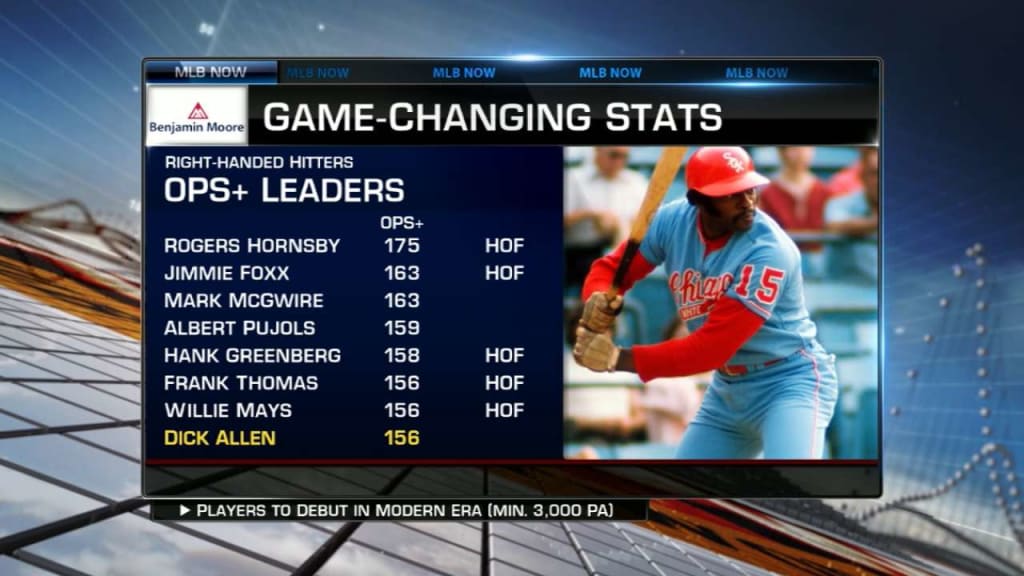OPS in baseball stands for On-base Plus Slugging, a composite statistic. It combines a player’s on-base percentage with their slugging percentage.
OPS is a valuable metric for evaluating a player’s overall offensive contribution, encompassing both their ability to reach base and their power hitting. It provides a quick snapshot of a player’s effectiveness at the plate, allowing for easy comparison with others.
A higher OPS indicates a more productive hitter, capable of advancing runners and potentially changing the game with a single swing. This statistic has gained popularity among analysts and fans alike for its simplicity and reliability in assessing a player’s offensive worth. Scouts, managers, and baseball enthusiasts often turn to OPS as a key indicator of a player’s prowess with the bat, making it an essential part of modern baseball analytics.
Ops In Baseball: The Game Changer
OPS revolutionized baseball statistics, acting as a true game changer. It combined two critical metrics, on-base percentage (OBP) and slugging percentage (SLG). This made understanding player performance much simpler. The stats tell a more complete story of a player’s offensive contributions.
The Dawn Of Ops In Baseball Statistics
In the late 20th century, OPS arrived in baseball. It gained popularity rapidly amongst sports analysts. This single metric revealed a batters’ ability to get on base and hit with power.
-
On-base Percentage (OBP) assesses the frequency a batter reaches base (excluding fielding errors or fielder’s choice).
-
Slugging Percentage (SLG) gauges the power of a batter’s hits. It measures the total bases a player achieves per at-bat.
Comparing Traditional Stats With Ops
OPS adds a deeper layer of understanding compared to traditional batting average. The batting average fails to consider the type of hit. OPS provides a fuller picture of a player’s offensive strength.
Example: Baseball Player Stats Comparison.
| Player | Batting Average | OPS |
|---|---|---|
| Player A | .300 | .900 |
| Player B | .350 | .790 |
The above table illustrates a scenario. Player A has a lower batting average than Player B. But, Player A’s OPS is higher. This hints that Player A may be a more effective offensive player.

Credit: dodgers.mlblogs.com
Breaking Down Ops
When it comes to baseball data, OPS is a crucial stat to understand. Let’s start by Breaking Down OPS to uncover its secrets.
Components Of Ops: Obp And Slg
OPS stands for On-base Plus Slugging. It combines two crucial baseball stats: OBP (On-Base Percentage) and SLG (Slugging Percentage). Let’s take a closer peek.
- OBP: This statistic shows how often a player reaches base. It includes hits, walks, and hit-by-pitches.
- SLG: This reveals a player’s power. It factors in the total bases a player earns on hits.
Put together, OPS gives a round picture of a player’s batting skill and power.
Calculating The Magic Number
To find OPS, you’ll need to perform some simple addition. Just add a player’s OBP to their SLG. Here’s a quick guide:
OPS = OBP + SLG
Finding OPS can help you pinpoint a player’s ability in a snap. Remember, a higher OPS means a more powerful, effective batter!
| Player’s Name | OBP | SLG | OPS |
|---|---|---|---|
| Player 1 | 0.340 | 0.500 | 0.840 |
| Player 2 | 0.380 | 0.560 | 0.940 |
In this example, Player 2 has a higher OPS, so they are more effective at batting.
The Impact Of Ops On Player Evaluation
The Impact of OPS (On-base Plus Slugging) has revolutionized the way baseball players are evaluated. This metric has provided a deeper understanding of a player’s offensive value. Teams and analysts now look beyond traditional stats like batting averages. They focus on a player’s ability to reach base and hit for power.
Redefining Player Value
OPS combines on-base percentage (OBP) with slugging percentage (SLG). This blend highlights players who excel at both getting on base and hitting for extra bases. Here’s why OPS has gained importance:
- Simple yet Comprehensive: OPS is easy to understand. It offers a snapshot of player productivity.
- Better Performance Indicator: It correlates more with run production than traditional metrics.
- Cost-Effective Decisions: Teams utilize OPS for scouting and contracts to get the best value.
Case Studies: Players’ Success Stories With Ops
Several players have illustrated the value of OPS in their careers:
| Player Name | OPS Before | OPS After | Career Impact |
|---|---|---|---|
| David Ortiz | .839 | 1.066 | Elevated to MVP contender |
| Joey Votto | .841 | .957 | Secured lucrative contract |
These players highlight how OPS can demonstrate value that might otherwise be overlooked. It encourages a closer look at how individuals contribute to their team’s scoring potential. Therefore, OPS remains a vital tool in player evaluation and overall strategy in Baseball.

Credit: www.amazon.com
Metrics Interplay: Ops And Advanced Analytics
On-base Plus Slugging (OPS) is a staple statistic in baseball analytics. It combines a player’s ability to reach base with their power at the plate. As baseball delves deeper into the era of advanced analytics, OPS remains a relevant and potent metric. However, it now interacts with more intricate data to paint a complex picture of a player’s value.
Beyond Ops: Integrating New-age Stats
The landscape of baseball statistics is rich and ever-expanding. OPS is fundamental but not the only measure of a player’s prowess. Baseball analysts have developed novel metrics that capture different aspects of the game:
- WAR (Wins Above Replacement): This stat estimates a player’s total contribution to their team in terms of wins.
- wRC+ (Weighted Runs Created Plus): Adjusts a player’s runs created for ballpark factors.
- UZR (Ultimate Zone Rating): Quantifies a fielder’s defensive worth.
- BABIP (Batting Average on Balls in Play): Can indicate luck by showing performance with balls that defenders play.
Collectively, these stats offer a multi-dimensional view that goes beyond the traditional OPS.
How Ops Complements Other Metrics
OPS serves as the cornerstone, aligning with newer analytics for a comprehensive assessment:
| Metric | Role |
|---|---|
| OPS | Measures on-base ability and power |
| WAR | Evaluates overall player value |
| wRC+ | Contextualizes run creation |
| UZR | Gauges defensive contribution |
| BABIP | Assists in identifying luck factors |
While OPS highlights a hitter’s base-reaching and slugging ability, metrics like WAR and wRC+ adjust for context, and UZR focuses on defense. Together, they form a nuanced evaluation of players. The interplay of these metrics, with OPS at the foundation, allows for a deeper understanding of a player’s comprehensive impact on the game.
Controversies Surrounding Ops
OPS, or On-base Plus Slugging, in baseball has made waves due to its marked controversies. These mainly hover around its limitations and potential alternatives. Let’s delve deeper into these aspects.
Limitations And Criticism Of Ops
The calculation of OPS in baseball may seem straightforward, but critics point to various issues. Firstly, it uses simple addition. Many argue this method lacks sophistication. It treats on-base percentage (OBP) and slugging percentage (SLG) equally when they bear different values.
Secondly, OPS does not consider the player’s context. It offers no insight into the team’s performance, field conditions, or opposition quality. It paints a skewed picture of a player’s efficiency.
Adjustments And Alternatives To Ops
Due to OPS’s limitations, adjustments and alternatives have emerged.
- wOBA: Short for Weighted On-base Average, it deals with OPS’s unequal treatment of OBP and SLG. wOBA assigns each of these aspects proper relative weights.
- OPS+: This alternative takes factors beyond the player’s control into account. It adjusts OPS to negate the effects of the ballpark or league average.
- Weighted Runs Created Plus (wRC+): wRC+ considers the number of runs a player produces. It provides a more holistic view of a player’s effectiveness.
Bearing these in mind, it’s clear OPS is not without its flaws. Nevertheless, its adjustments and alternatives strive to paint an accurate picture of a player’s performance.
The Future Of Ops In Baseball
The Future of OPS in Baseball is a fascinating topic. On-Base Plus Slugging (OPS) shapes how we understand and predict player performance. With technology’s help, OPS becomes even more refined. Let’s glimpse into the exciting developments of baseball stats!
Technological Advancements Influencing Ops
As technology progresses, OPS goes far beyond batting averages and slugging percentages. Here are a few examples:
- Improved Analytics: New software helps teams analyze raw data. They generate accurate stats, enhancing OPS.
- Player Tracking: High-speed cameras and radars track every move on the field. It gives a deeper insight into OPS.
- Artificial Intelligence: AI predicts player efficiency and outcomes, contributing to OPS calculations.
Predicting The Next Revolution In Baseball Stats
The future of baseball metrics is exciting. Here’s what we might see next:
- Incorporating Physical Stats: Players’ physical fitness could factor into OPS. It would reflect their endurance and performance.
- Virtual Reality: VR might help simulate game situations. It could impact OPS predictions.
- Better Error Detection: Advances could lead to a higher accuracy in identifying and correcting errors in OPS.

Credit: www.mlb.com
Frequently Asked Questions On What Is Ops In Baseball
What Is A Good Ops In Baseball?
An OPS (On-base Plus Slugging) above. 800 is considered good in baseball, with elite hitters often exceeding. 900.
How Do I Calculate Ops In Baseball?
To calculate OPS (On-base Plus Slugging) in baseball, add the player’s on-base percentage (OBP) to their slugging percentage (SLG). The formula is OPS = OBP + SLG.
What Is The Highest Ops In Baseball?
The highest OPS (On-base Plus Slugging) in baseball history is 1. 164, held by Babe Ruth. He achieved this remarkable career score through his exceptional batting performance.
What Does A 1 Ops Mean In Baseball?
In baseball, a 1 OPS signifies an exceptional performance. It’s the combination of a player’s on-base percentage (OBP) and slugging percentage (SP). High OPS indicates superior hitting skills.
Conclusion
Understanding the significance of OPS in baseball elevates our appreciation of the sport. The more skilled a player is at producing runs, the higher their OPS. This statistic proves invaluable for strategizing and evaluating player efficiency. Indeed, OPS cements its place as a crucial tool in baseball analytics offering insights beyond traditional metrics.









